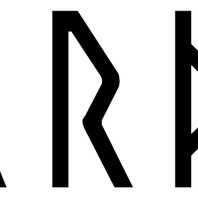
Viking Names
Thord
The Old Norse male name Þórðr is one of the commonest in Scandinavian, particularly Norway and Iceland. While it is not especially common in English place-names, it is found in Torworth, Nottinghamshire.
Read More
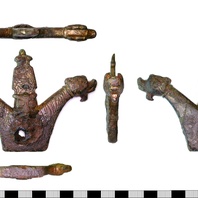
Viking Objects
Mystery Item
A gilded, copper alloy object that was clearly affixed to something else. The gilding shows that it was high status but its function remains a mystery.
Read More

Blog Post
A Poet Visits Grimsby
Statue of Earl Rögnvaldr of Orkney in St Magnus Cathedral, Kirkwall. Photo © Judith Jesch Grimsby is one of the few places in the East Midlands mentioned in an Icelandic saga. In Orkneyinga saga the Norwegian poet (and later Earl of Orkney) Rögnvaldr Kali Kolsson joins up at the age of fifteen with a group of Norwegian merchants for his first trip abroad. The date of this is uncertain, but it was probably around 1130. The saga says (ch. 59) that there were a lot of people there from Orkney, the Hebrides and from mainland Scotland. In Grimsby, according to the saga (and it’s the only saga that has this anecdote), Rögnvaldr meets an Irish-Hebridean called Gillikristr who claims his real name is Haraldr and that he is the son of the Norwegian king Magnús Barelegs. It’s a blind anecdote, since nothing comes of it, and Gillikristr is never mentioned again, but the two part on friendly terms. The real reason for the anecdote in the saga is to introduce one of Rögnvaldr’s poems (ch. 60). He was an excellent poet – 32 of his stanzas survive and many of them are justly famous. Unfortunately, his poem on Grimsby does not present a flattering picture of the place, rather it expresses the poet’s delight to be heading back to Norway across the refreshing waves after five weeks in a muddy Grimsby (text and translation from Jesch 2009): Vér hǫfum vaðnar leirur vikur fimm megingrimmar; saurs vasa vant, es vôrum, viðr, í Grímsbœ miðjum. Nús, þats môs of mýrar meginkátliga lôtum branda elg á bylgjur Bjǫrgynjar til dynja. We have waded the mud-flats for five mightily grim weeks; there was no lack there of muck when we were in the middle of Grimsby. Now it is the case that mightily merrily we cause {the elk of the prow} [SHIP] to boom on the waves to Bergen across {the marshes of the gull} [SEA]. Although unflattering, the poem is probably accurate. The coastal landscape around Grimsby is characterised by both mud-flats and salt-marshes and the town itself was virtually an island with only one road into it at the end of the Middle Ages. The stanza appears to describe the Norwegians’ daily journey across the mud-flats to the town from their mooring-place in the haven during their five-week business trip. The sea-kenning mýrar môs ‘marshes of the gull’ is ironic since the sailors have left the marshes behind and the contrast is underlined by the two descriptors in megin- ‘mightily’, which contrast the grimness of their weeks in Grimsby with their pleasure at setting off for home. Supported by the poem, the anecdote confirms that, even after the end of the Viking Age, the Scandinavian parts of England still had extensive contacts with other parts of the Viking diaspora, in this case merchants from Norway and Scotland. Finnbogi Guðmundsson (ed.) 1965. Orkneyinga saga. Íslenzk fornrit 34. Reykjavík. Hermann Pálsson and Paul Edwards (trans.) 1978. Orkneyinga saga. Penguin. Jesch, Judith (ed.) 2009, ‘Rǫgnvaldr jarl Kali Kolsson, Lausavísur 2’ in Kari Ellen Gade (ed.), Poetry from the Kings’ Sagas 2: From c. 1035 to c. 1300. Skaldic Poetry of the Scandinavian Middle Ages 2. Turnhout: Brepols, pp. 577-8.
Read More
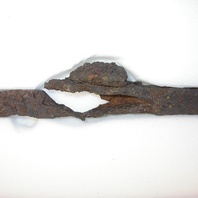
Viking Objects
Sword Fitting (1985/225-13)
This is the lower guard of a sword that may have been a Petersen Type H sword with triangular pommel. This style of sword is the most common type found in Norway and accounts for approximately 25% of those found in Ireland. It was found about 760mm from an iron sword blade in Mound 7, along with iron nails and a fragment of a possible iron spur.
Read More
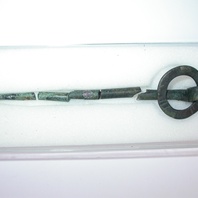
Viking Objects
Ring-headed Pin (2004-311-sf245)
This ring-headed pin was uncovered in a cremation burial which was generally unfurnished and containing little evidence. This type of pin was fairly common throughout the Viking Age and was used to hold a cloak around one’s body.
Read More
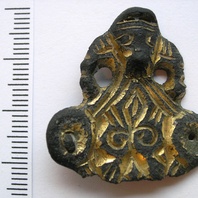
Viking Objects
Equal-Armed Brooch (SWYOR-50BAF5)
A fragment of a Viking Age equal-armed brooch found at Harworth Bircotes, Nottinghamshire. This fragment is the terminal of the brooch and resembles brooches found at Birka, Sweden. Its decoration consists of a Borre style animal with gripping arms or legs. This is one of only six Scandinavian, Viking period equal-armed brooches recorded in England. For more information on Scandinavian jewellery in England check out our blog: Brooches, Pendants and Pins: Scandinavian Dress Accessories in England.
Read More
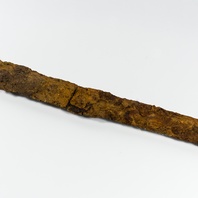
Viking Objects
Sword (1989-59/7113)
This Viking Age sword was found in Grave 511 at Repton where the invading Viking Great Army had their winter camp in 873/4. When it was found, the sword had traces of a wooden scabbard attached to the rusted blade. Analysis showed that the scabbard was lined with fleece and covered in leather. The grip was wooden and covered in a woollen textile.
Read More
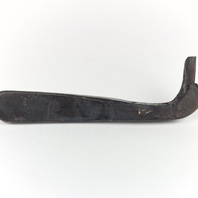
Blog Post
Unlocking the Meaning of Keys in the Viking Age
A reproduction iron key based on one from Repton, Derbyshire Most keys that have been found are from graves, and were deliberately buried with individuals. The fact that only some people were buried with keys shows that keys had both practical and symbolic functions in the Viking Age. The practical function of keys was to lock locks, as is to be expected. They secured items against access or theft, and their presence indicates that the owner of the key actually had valuables worth locking up. Viking Age keys, padlocks and locks have all been found by archaeologists. The locks and padlocks probably belonged to chests and were used to secure a person’s most important belongings. Chests were used as storage at home and as travelling luggage by sailors going abroad. The chest provided a secure place to keep personal belongings, and was also used as a seat for the rowers. Keys could be decorated, like one from Gjerdal in Norway, which had been decorated with stylized animal heads and geometric ornamentation that dates it to the Viking Age. Keys are found as a part of burial paraphernalia in Scandinavia from the Migration Period through the Viking Age, and were usually made of iron or copper alloy. Although often viewed as primarily grave goods, in reality they have also been found on settlement sites throughout Scandinavia, and as single finds. Received wisdom states that they are most commonly found in women’s graves, and occasionally in men’s graves. However, they are not a common find overall. Only a small number of keys have been found compared to the large number of excavations undertaken. Most importantly, this applies to graves, where Berg (2015, 130) notes that of 6000-8000 graves excavated in south-east Norway only 117 contained keys. She also shows that keys are not a predominantly female accessory, as is usually stated. The Museum of Cultural History in Oslo notes that approximately 75 copper alloy keys and 170 iron keys of Viking Age date have been found in south-east Norway alone. The copper alloy keys are all different, showing that they were not mass-produced, but rather cast individually. Moulds for keys and smiths’ tools have been found during the excavations at Kaupang in Norway, providing the key to understanding how keys were made. Keys had symbolic value which has most often been taken to indicate the social function of the bearer. As items that provided access and closed it off, they indicated that the bearer had these powers too. This symbolic value has been most associated with women, largely because medieval law codes such as Borgartingslova (the Borgarthing Law) which dates from the twelfth or thirteenth century, identify keys ‘as a signifier for the key-bearer, sometimes described as a woman or housewife’ (Berg. 2015, 127). In the Eddic poem Þrymskviða Thor must dress up as Freyja. Part of his disguise is a set of keys hanging from his belt leading to the suggestion that Freyja may have been particularly associated with keys as a symbol of her domain. This image of powerful women controlling access to the house has led to an enduring image of the Viking Age matriarch wearing keys on her belt or hanging from a brooch to show that she was the gatekeeper in the household. However, this raises the question of what keys are doing in men’s graves, as in the case of Grave 541 at Repton, Derbyshire. Norse laws from the medieval period demonstrate that keys symbolised control over the household, a female area of power, and reinforce this idea. Given that keys symbolized power, ownership and control of access, it is likely that keys in men’s graves are indicators of their status as owners too. They may not have carried them in life, but keys as grave goods symbolise their power after death. Beyond simple interpretations of keys indicating ownership, Pantmann (2014, 52) suggests that keys had a cultic role in pagan Scandinavia. The concept of the ‘kloge kone’ or ‘wise woman’ may have been symbolised by keys, because keys have a universal symbolic value indicating knowledge, power, and insight. In this role, they are associated with Freyja and thus childbirth, the afterlife (Freyja receives half of those slain in battle into her hall Sessrúmnir), and female leadership, a role that is closely associated with the role of matriarch of a household. Berg (2015, 127) notes that the connection between keys and childbirth is that the keys symbolically unlock the womb or loins to ensure a successful birth. Keys are also associated with Christianity. The triquetra found on some keys may be associated with the Holy Trinity, but may also be a pre-Christian symbol of fertility and motherhood (Berg, 128). The focus on keys as symbols of women’s power is not supported by the archaeological evidence, so it is likely that keys are not symbolic of the housewife alone. However, it is noteworthy that decorated bronze keys are almost exclusively linked to women while iron keys are not (Aannestad. 2004, 80). The fact that keys were buried with certain people is a clear indicator of symbolic significance; the dead are buried with items that are important to them or to those that buried them. Those items gain significance by being chosen to be included as grave goods. Thus keys had symbolic significance, and it may have been related to power and access. This is supported by their rarity as finds, indicating that they belonged to the few, not to the many, and it is likely that those few were the ones who had wealth or treasures that needed locking away. Keys are symbols of wealth and access to power, and perhaps symbolise the ability to affect one’s environment through ritual action (Berg. 2015, 132), but their use as symbols is nuanced and may represent different things at different points in the Viking Age, and in different places within the Viking diaspora. As a result, unlocking the meaning of keys in the Viking Age is not simple. Further Reading: Aannestad, Hanne Lovise. 2004. “En nøkkel til kunnskap – Om kvinneroller i vikingtid”. Viking. Berg, H. L. 2015. “’Truth’ and reproduction of knowledge. Critical thoughts on the interpretation and understanding of Iron-Age Keys”. In Marianne Hem Eriksen, Unn Pedersen, Bernt Rundberget, Irmelin Axelsen and Heidi Lund Berg (eds). Viking Worlds: Things, spaces and movement. Oxbow Books: Oxford. Pantmann, Pernille. 2014. “Nøglekvinderne” in Kvinner i vikingtid. Ed. by Nancy Coleman and Nanna Løkka. Scandinavian Academic Press: Oslo. Pp 39-56.
Read More

Blog Post
Viking Leicestershire: The Artefactual Evidence, Part 1 Museum Collections
As part of the Danelaw with a county town listed amongst the Five Boroughs, Leicestershire is rich in Scandinavian influence. The county is littered with ‘Scandinavian’ place names (e.g. Harby) and we are lucky that chance finds and excavations in the city of Leicester have revealed a few distinctly Viking or Anglo-Scandinavian artefacts. The following highlights some of these finds and where they can be seen or are held. Jewry Wall Museum, Leicester Pendant from Highcross Street, Leicester (LA18.1860) (c) Wendy Scott Victorian chance finds from Leicester include a pendant, with an openwork writhing beast in a circular frame from Highcross St. (LA18.1860). Two beautifully carved bone objects were also recovered from there: a beast’s head with gaping mouth and a ‘tongue’ shaped strap end decorated with interlace and cat-like masks (LA67.1864). Kenyon’s excavations at Jewry Wall in 1948 found an unusual mount akin to an oval brooch (JW85.1) and two ‘Norse’-type ring-headed pins (LA33.1951) with a third already recovered from Cank St. in 1912 (LA116.1962). Just outside the city at Aylestone church, a wonderful stone object was found. It’s a grave cover which appears to be Scandinavian in style with ‘triskeles’ and beasts decorating its surface (LA103.1969). Unfortunately, Jewry Wall Museum is closed for renovations as this blog is posted. Charnwood Museum, Loughborough Peterson Type X sword pommel (LEIC-9158C3) (c) Wendy Scott In the county, we have the rare silver Thor’s hammer pendant from Thurcaston on display at Charnwood Museum (PAS ref LEIC-185125). It was found by the same person who found our only Viking coin hoard, the Thurcaston hoard (LEIC-C6D945), which is currently held at The Fitzwilliam Museum, Cambridge but is unfortunately not on display. The hammer-shaped pendant was very rare when found in 1991, but we now have 22 examples on the Portable Antiquities Scheme database, including a rare gold Thor’s hammer from East Lincolnshire (LIN-D3E540) which has similar decoration to the Thurcaston one. We also have a very rare sword pommel (Peterson type X LEIC-9158C3) from Ravenstone, metal detected and donated by the finder. It features ‘Ringerike’ ribbon-like decoration, dating it to the early 11th century. This is not yet on display but will be at Charnwood Museum for a temporary display in the Spring. Melton Carnegie Museum, Melton Mowbray Stirrup mount from Kirby Bellars (LEIC-51E6F2) (c) Wendy Scott In Melton Museum we have objects that are Anglo-Scandinavian, including a very rare stirrup mount from Kirby Bellars (LEIC-51E6F2). The only one of its type from Britain, its only parallel being continental and in the British Museum. We also have a harness strap distributor, one of many Anglo-Scandinavian horse accessories recorded with the Portable Antiquities Scheme. Further reading Stirrup mounts – https://finds.org.uk/counties/leicestershire/a-pair-of-stirrup-strap-mounts
Read More

Viking Talks
Distinctiveness and Assimilation: Rediscovering Viking Age Stone Sculpture in the East Midlands
Stone sculpture provides evidence for the assimilation of the Vikings into Anglo-Saxon society, where Anglo-Saxon motifs are combined with Norse motifs to produce hybrid forms. In this talk, Paul Everson of the University of Keele will explore Viking Age stone sculpture in the East Midlands showing its characteristic elements and how hybrid forms emerged. Paul Everson Wednesday 7 February 2018
